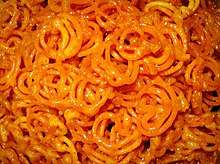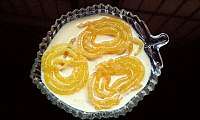Jalebi
Jalebi, also known as zulbia, jilapi, mushabak and zalabia, is an Arab and Indian sweet snack popular all over South Asia, and the Middle East. It is made by deep-frying maida flour (plain flour or all-purpose flour) batter in pretzel or circular shapes, which are then soaked in sugar syrup.
 Jalebis as served in Uttar Pradesh, India. | |
| Alternative names | see names |
|---|---|
| Course | Dessert |
| Place of origin | Western Asia (Zalabiyeh or Luqmat al qadi)[1] Egypt (al-fayyum)[1] |
| Region or state | South Asia, West Asia |
| Serving temperature | Hot or cold |
| Main ingredients | Maida flour, saffron, ghee, sugar |
| Variations | Jahangiri or Imarti, Shahi jilapi |
This dessert can be served warm or cold. They have a somewhat chewy texture with a crystallized sugary exterior coating. Citric acid or lime juice is sometimes added to the syrup, as well as rose water. Jalebi is eaten with curd or rabri (North India) along with optional other flavours such as kewra (scented water).
This dish is not to be confused with similar sweets and variants like imarti and chhena jalebi. Another similar looking sweet, Jeri which is popular throughout Nepal is different from Jalebi.
Names
Names for the dish include
South Asia:
- Hindi: जलेबी (jalebi);
- Nepali: जेरी (jeri);
- Marathi: जिलबी (jilabī);
- Bengali: জিলাপি (jilāpi);
- Assamese: জেলেপী (jelepi);
- Gujarati: જલેબી (jalēbī);
- Kannada: ಜಿಲೇಬಿ (jilēbi);
- Malayalam: ജിലേബി (jilēbi);
- Odia: ଝିଲାପି (jhilāpi);
- Punjabi: ਜਲੇਬੀ (jalēbī);
- Tamil: ஜிலேபி (jilēbi);
- Telugu: జిలేబి (jilēbi);
- Tagalog: jalebie;
- Sinhala: පැණි වළලු (pæṇi vaḷalu);
- Sylheti: ꠎꠤꠟꠣꠚꠤ (zilafi);
- Sindhi: جلیبی (jalebi);
- Urdu: جلیبی (jalebi);
West Asia
- Persian: زولبیا (zulbia);
- Pashto: ځلوبۍ (źəlobəi);
- Central Kurdish: زۆلبیا، زلابیە (zolbîya, zilabîye);
- Southern Kurdish: زوولبیا، زوولیبیلیا (zûlbîya, zûlîbîlîya);
- Lurish: زلهیبی (zuleybi);
- Azerbaijani: zülbiyə
- Arabic: زلابيه (zalābiyeh) or زلبي (zalebi);
- Turkish: müşebbek, zülbiye
North Africa
- Somali: مُشَبَك (mushabbak);
- Egyptian Arabic: مِشَبٍك (meshabek);
- Tunisian Arabic: زلابيه (zlebia);
- Harari language: ሙሻበኽ (mushabakh).
East Africa
- Mauritian Creole: Moutaille or Gato Moutaille
History
Zalabia
Zalabia or Luqmat al qadi consisted of a yeast dough fried and then dipped in a syrup of honey and rose water[3]
In Iran, where it is known as zolbiya, the sweet was traditionally given to the poor during Ramadan. A 10th century cookbook gives several recipes for zulubiya. There are several 13th century recipes of the sweet, the most accepted being mentioned in a cookbook by Muhammad bin Hasan al-Baghdadi.[2] It was also mentioned in a tenth century Arabic cookbook by Ibn Sayyar al-Warraq, that was later translated by Nawal Nasrallah.[4][5]
Ernest A Hamwi, a Syrian immigrant to the United States, is believed to have used the Persian version zalabia as an early ice cream cone.[2]:404
Modern jalebi
According to Hobson-Jobson, the Indian word jalebi is derived from the Arabic word zulabiya or the Persian zolbiya[6], another name for luqmat al qadi.This recipe was brought to Medieval India by Persian-speaking Turkic invaders.[7] In 15th century India, jalebi was known as Kundalika or Jalavallika. Priyamkarnrpakatha, a work by the Jain author Jinasura, composed around 1450 CE, mentions jalebi in the context of a dinner held by a rich merchant.[2] Gunyagunabodhini, another Sanskrit work dating before 1600 CE, lists the ingredients and recipe of the dish; these are identical to the ones used to prepare the modern jalebi.[8] The western Asian dish of Zalabia used a different batter and a syrup of honey and rose water, It was in India that the Indian jalebi got its distinct form - crispness, colour and the sticky sweetness.[9]
Distribution
Indian subcontinent
In the Indian subcontinent, it is known as "Jalebi" in Hindustani and served with sweetened condensed milk dish, rabri or eaten with kachori and vegetable curry in the northern part of the Indian subcontinent.
In Bangladesh, this sweet is called "Jilapi" in Bangladesh which is broadly cosumed as an essential item of iftar or snacks.
This sweet is called "jeri" in Nepal, a word derived from Jangiri and the Mughal Emperor Jahangir.[10]
Pani Walalu or "Undu Walalu" is a traditional sweet of Sri Lanka prepared by frying a type of doughnut, made by using undu flour and rice flour and soaking in kithul treacle.
In the Maldives, it is known by the name "zilēbi".
Middle East and North Africa
Iran
It's known as zoolbia[11] (زولبیا) in Iran, although when translated into English, the spelling has alternatives and can include zolbiya, zulbiā, zulbia, zolbia, and others. In addition to being sweetened with honey and sugar, zoolbias in Iran is also flavoured with saffron or rose water.[11][12] Often in Iran, zoolbia is served with Persian-style black tea alongside a similar dessert with a different "egg" shape, Bamiyeh.[13] These deserts are commonly served during Nowruz (Persian New Year)[13][14] and Ramadan month.
Middle East and North Africa
Zlebia or zlabia is a type of pastry eaten in parts of Northwest Africa, such as Algeria, Tunisia and Libya as well as Somalia Morocco. Natural ingredients include flour, yeast, yoghurt, and sugar or honey. This is then mixed with water and commonly two seeds of cardamom (oil for the crackling).
These are found in the Levant and other Middle Eastern countries, including the Arab countries of Yemen, Egypt,[15] Syria, Lebanon, Iraq, and Comoros. Zalābiya or zalabia, zalabiya (زلابية) (Maghrebi Arabic: زلابية) are fried dough foods, including types similar to straight doughnuts.[16] Zalābiya are made from a batter composed of eggs, flour and milk, and then cooked in oil. They are made by a zalbāni. Unlike jalebi, zalabia may have a different shape, more like a free-form doughnut or a ball (but this is depending on the exact region and culture), and it may contain cinnamon, lemon, and powdered sugar.[16][17]
Variations of the recipe
Zalābiya mushabbaka are latticed fritters made in discs, balls and squares. They are dipped in clarified honey perfumed with rose water, musk and camphor. A recipe from a caliph's kitchen suggests milk, clarified butter, sugar and pepper to be added.
Zalābiya funiyya is a "sponge cake" version cooked in a special round pot on a trivet and cooked in a tannur.[18] They are often stick shaped. They are eaten year-round, including in expatriate communities such as in France, although they are especially popular during Ramadan celebrations.[19]
.jpg) Jilapi in Bangladesh, generally consumed as a sweetmeat, happens to be one of the popular starters in different parties.
Jilapi in Bangladesh, generally consumed as a sweetmeat, happens to be one of the popular starters in different parties.- Shahi jilapi a huge and circle shaped jilapi, is the Dhakaiya version of jilapi from the Old Dhaka of Bangladesh which is very popular among the Dhakaiyas and all over Bangladesh.
- Zulbiā and bāmieh in Iran
 Jalebi dipped in rabri
Jalebi dipped in rabri
See also
References
- Sengupta, Sushmita. "History Of Jalebi: How The Coiled and Sugary West Asian Import Became India's Favourite Sweetmeat". ndtv.
- Alan Davidson (21 August 2014). The Oxford Companion to Food. Oxford University Press. pp. 424–425. ISBN 978-0-19-967733-7.
- Alan Davidson (21 August 2014). The Oxford Companion to Food. Oxford University Press. pp. 424–425. ISBN 978-0-19-967733-7.
- al-Warraq, Ibn Sayyar; Nasrallah, Nawal (26 November 2007). annals of the caliphs' kitchens. BRILL. p. 413 chapter 100.
- al-warraq, ibn sayyar. "كتاب الطبيخ؛ وإصلاح الأغذية المأكولات وطيبات الأطعمة المصنوعات مما استخرج من كتب الطب وألفاظ الطهاة وأهل اللب". goodreads. Retrieved 17 September 2018.
- Hobson-Jobson, s.v. "JELAUBEE"
- Michael Krondl (1 June 2014). The Donut: History, Recipes, and Lore from Boston to Berlin. Chicago Review Press. p. 7. ISBN 978-1-61374-673-8.
- Dileep Padgaonkar (15 March 2010). "Journey of the jalebi". The Times of India. Retrieved 25 August 2014.
- Dash, Madhulika. "The 'sweet' India". Khaleej Times. Retrieved 27 January 2019.
- "Jalebi khani hai?". The Times of India. 7 January 2009.
- "Iranian Recipes: Zoolbia & Baamieh". Iran Chamber Society. Retrieved 3 March 2019.
- "Saffron zoolbia (deep-fried pastry with saffron sugar syrup)". Food. Retrieved 3 March 2019.
- Newfield Metzelthin, Pearl Violette, ed. (2007). "Contents". Gourmet Magazine. Condé Nast Publications: 586.
- Nelson, Suzanne (2017). Donut Go Breaking My Heart: A Wish Novel. Scholastic Inc. ISBN 1338137433.
- Maya Shatzmiller (1993). Labour in the medieval Islamic world. BRILL. p. 110. ISBN 978-90-04-09896-1.
- "Middle Eastern Vegan Donuts (Zalabia)". The Mediterranean Dish. 9 February 2016. Retrieved 3 March 2019.
- "Egyptian Zalabia Balls Recipe". www.middleeastkitchen.com. Retrieved 3 March 2019.
- Translated by Nawal Nasrallah Annals of the caliphs' kitchens: Ibn Sayyār al-Warrāq's tenth-century Baghdadi cookbook Volume 70 of Islamic history and civilization Edition illustrated 2007 ISBN 978-90-04-15867-2. 867 pages BRILL page 413-417
- Hadi Yahmid French Ramadan About Solidarity IslamOnline